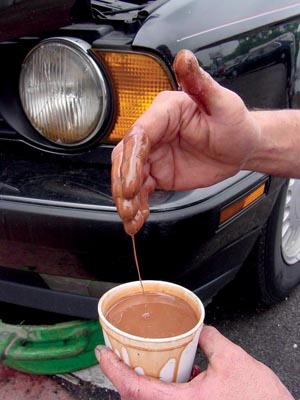 So why does the coolant turn to orange sludge in some vehicles? The problem has been blamed on a combination of factors including low coolant level due to a faulty radiator cap or lack of maintenance, oxygen in the cooling system, using water contaminated with minerals or salts, and adding non-approved coolants to the vehicle.
So why does the coolant turn to orange sludge in some vehicles? The problem has been blamed on a combination of factors including low coolant level due to a faulty radiator cap or lack of maintenance, oxygen in the cooling system, using water contaminated with minerals or salts, and adding non-approved coolants to the vehicle.
To avoid sludge problems, the cooling system must be kept full. Close attention also needs to be paid to the radiator cap. A cap that does not seal properly or is contaminated with rust or dirt can allow coolant loss and air to enter the system. The cap should be pressure-tested and replaced if it fails to hold pressure. If contamination forms inside the cooling system, the debris tends to gum up the pressure relief valve in the drop-center style caps. This may prevent the valve from properly sealing, allowing a loss of pressure in the system, coolant loss and additional air contamination that only accelerates corrosion.
Nissan has issued a radiator cap-related service bulletin for its 1999 and later vehicles. TSB #NTB04-018 says overheating and coolant loss problems can be caused by a radiator cap that does not seal properly. The bulletin advises technicians to inspect the gasket on the underside of the cap to see if the gasket is swollen (enlarged) as this can prevent the cap from sealing properly.
BMW issued a recall (#98V178000 in August 1998) covering a radiator cap issue on 1995 5 series BMWs. The OEM radiator cap apparently holds too much pressure and may cause the heater core to burst if the engine overheats. The fix here was to replace the original cap with one that vents at a lower pressure to reduce the risk of passengers being burned by hot coolant blowing out of a ruptured heater core.
Wrong Coolant Mix
In some instances, coolant sludge can occur if the coolant contains too much antifreeze and not enough water, or there is not enough antifreeze in the coolant and corrosion takes over. The recommended coolant mix is almost always 50/50. But if the radiator is drained and refilled without flushing the system, mixing new coolant with old may result in coolant that is too diluted or over-concentrated. Over-diluted coolant (too much water) may prevent the chemical inhibitors from stopping rust, allowing metal surfaces to corrode.











